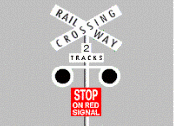A. Stop completely at all times.
 Even if the signal at a railway level crossing does not indicate that a train is coming, you should:
Even if the signal at a railway level crossing does not indicate that a train is coming, you should:
A. Stop completely at all times.
B. Speed up and cross the tracks quickly.
C. Slow down, be ready to stop and give way if there is danger of collision.
In various parts of Australia you will come across many trains. Some crossings will be well sign-posted and will have barrier arms, bells and flashing lights, such as in metro areas; others may have limited signage such as the cane railroads in Northern Queensland. Regardless of where you cross railway tracks, though, you should always take the same precautions.
There are over 3000 crossings in New South Wales. Around 1400 of these are on public roads and the rest are on private roads. In general few accidents occur at level crossings but they do have the potential to be very serious. There were 87 fatal accidents in NSW at level crossings between 1988 and 1998. 83% occurred in daylight, and 85% in dry, fine weather. 89% occurred on a straight road. So, the majority of accidents are in what could be called ideal conditions for driving, and are therefore easily preventable. In fact, only 13% were due to adverse weather or road conditions according to Transport for NSW.


A railway level crossing is where railway tracks cross a road and you must drive your vehicle directly over the tracks - the tracks and the road are at the same grade (level). The level crossing is usually indicated by one or more signs, most often a crossbuck (a metal cross with railway crossing written on it, or a graphical representation of this) often with the number of tracks to cross written underneath (e.g. 2 tracks), and a train sign with the distance ahead written underneath, such as 200m.


If a crossing is on a side road the sign will indicate this. If you are turning right into the road, be sure that there is not a hidden queue of vehicles that will prevent you from fully crossing the lane into the junction otherwise you will be stranded with traffic coming in the opposite direction. This is particularly important if you are driving a long vehicle. This applies also when you are approaching any crossing - always make sure there is enough room the other side of the crossing for your vehicle. If you are driving a road train or other long vehicle you will need to be especially careful.


Other signs may indicate which direction the railway approaches from. If it's at an oblique angle, take extra care looking in your blind spots, especially if it's a crossing with no lights or barriers. Always look twice in each direction and be prepared to stop if you have to - don't try to race the train as they can be travelling much faster than a car and cannot stop quickly.
For a full set of signs, see this article.
If there are lights flashing or a boom or barrier has come down then you must stop. If a train passes and the lights continue to flash or the barrier doesn't move another train might be coming, so remain where you are.
There will be a white stop line which you must stop at and remain behind unless you can make it across. If you can see a train approaching then wait for it as trains can be travelling as fast as cars and cannot stop quickly. A laden freight train can take up to two kilometres to stop. Even light rail can take over 200m to stop.
There are many crossings in the countryside that have no booms, gates or flashing lights. Slow down, look and listen for trains in both directions.
If you are carrying flammable, explosive or dangerous goods you must stop between three and 15 metres before the crossing regardless of what type of crossing it is.
Long, low vehicles, motorcycles and cycles are at the most risk of becoming stuck on level crossings. Long, low vehicles can become beached if the crossing is slightly higher than the road. Motorcycle and cycle wheels can become stuck in the tracks. Tracks are also slippery, especially when wet.
If you break down on a crossing there are several things you can do.
Check that there is no train coming. If there is, get everyone out of the car and at least 50m away, preferably not in the direction that a train is likely to push your vehicle or spread debris.
Try to warn the train driver. Even though the train is unlikely to be able to stop, the driver can apply emergency brakes to help reduce speed.
If there is no train coming and you have a vehicle with a manual gearbox you can place the vehicle in a low gear, leave the clutch out and use the starter motor to propel the vehicle across the junction.
If the vehicle can be pushed, do so quickly with everyone out of the vehicle but do not spend long attempting this. It's best to warn the authorities or the police of your predicament so that they can alert any approaching trains.
If there is a vehicle with bull bars you might be able to have them help push your vehicle out of the way.
Always be aware of whether there's a train approaching and as soon as you see one, get well clear of the tracks.
Trains will crush other vehicles very easily, even large vehicles such as trucks.
Here's how you can get caught on tracks (not that it's likely to happen to you in these specific circumstances):